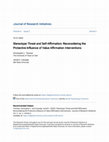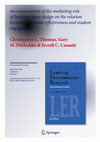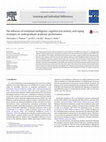Peer-Reviewed Publications by Christopher Thomas
The Journal of Research Initiatives, 2020
The purpose of the current article is to describe a set of empirically validated principles of pr... more The purpose of the current article is to describe a set of empirically validated principles of practice with the potential to enhance student learning and academic performance. Specifically, we provide an overview of Syfr Learning’s principles of practice – a collection of scalable instructional techniques derived from decades of research in the domain of learning science. Further, we provide an illustrative example of the benefits of Syfr Learning’s principles of practice when incorporated into existing curricula in a K-12 setting.

The Journal of Research Initiatives, 2020
The current study was designed to examine the influence of self-affirmation on learners' executiv... more The current study was designed to examine the influence of self-affirmation on learners' executive attention and mathematical performance when confronted with stereotype threat. Participants (N = 206) were exposed to self-affirmation and stereotype threat manipulations, completed operation-span and letter memory tasks, and a series of high-difficulty modular subtraction problems. Our results revealed that self-affirmed participants demonstrated lower mathematical performance when problems were completed under high stereotype threat conditions. Further, our data revealed the self-affirmation and stereotype threat manipulations had no impact on components of executive attention hypothesized to underlie stereotype threat effects. These findings add to recent literature calling into question the viability of self-affirmation as a strategy for protecting at-risk students' achievement.

Frontiers in Education , 2020
In the current investigation, we examined the association among emotional intelligence, emotional... more In the current investigation, we examined the association among emotional intelligence, emotional regulation tendencies, resilience, and perceived stress within a sample of undergraduate students. Participants (N = 277, 71% Female, 55% White) completed the Brief Emotional Intelligence Scale, Emotion Regulation Questionnaire, Brief Resilience Scale, and Perceived Stress Scale. Using path analysis techniques, we demonstrated that resilience was a negative predictor of perceived stress. Additionally, our results indicated that the use of cognitive reappraisal exerted an indirect influence on perceived stress through resilience. Finally, the current investigation provided evidence that emotional intelligence exerts an indirect influence on stress through both cognitive reappraisal and resilience. We believe the results of the current understanding expand our understanding of the determinants of effective emotional information processing and have implications for intervention efforts designed to reduce perceived stress within university-based samples.

Laterality: Asymmetries of Body, Brain and Cognition , 2015
Correlations between the relative speeds of left-to-right and right-to-left interhemispheric tran... more Correlations between the relative speeds of left-to-right and right-to-left interhemispheric transfer times and resting quantitative electroencephalography activity were examined in order to determine if variability in interhemispheric transfer was related to individual variability in resting neural firing patterns. Resting electroencephalography frequencies for 32 participants were regressed for 4 frequency bands at 8 different locations calculated for asymmetrical activation through subtracting the left from right average spectral power of each. Participants also completed a series of behavioural tasks that are typically localized to the right hemisphere (RH). Results indicate that the frontal medial average spectral power of the beta band is correlated with the speed of transfer such that larger resting beta values in the right as compared to left location are associated with faster right-to-left
interhemispheric transfer times and that larger resting beta values in the left as compared to right location are associated with faster left-to-right interhemispheric transfer times. Furthermore, enhanced performance on tasks typically localized to the RH is correlated with slower right-to-left interhemispheric transfer times, suggesting that the dominance of one hemisphere may come at a cost to interhemispheric communication.

Learning Environments Research, 2019
Ball State University re-designed five classrooms—as part of an Interactive Learning Space (ILS) ... more Ball State University re-designed five classrooms—as part of an Interactive Learning Space (ILS) Initiative—to provide educators with learning spaces that could be used to implement and assess the effectiveness of student-centred instructional practices. The purpose of the current investigation was to explore how pedagogy implemented within ILSs influenced student outcomes. Participants responded to questionnaires assessing perceived instructor effectiveness, perceived influence of ILS design on educational practices, academic engagement, and initial impressions of the learning spaces. The relationship between instructor effectiveness and academic engagement was partially mediated by the influence that interactive learning spaces exerted on the types of activities implemented during course sessions. Additionally, we identified two ILSs that differentially influenced levels of academic engagement reported by learners. The characteristics of ILSs that facilitate the implementation of effective instructional practices and promote positive student outcomes are discussed.

Personality and Individual Differences, 2017
In the present study, we examined group differences in Error-Related Negativity (ERN) based on pe... more In the present study, we examined group differences in Error-Related Negativity (ERN) based on perfectionism and emotional intelligence (EIQ). ERN is an ERP component that is generated in the anterior cingulate cortex and peaks 60-150 ms after making an error response on a task. The amplitude of the ERN after making a mistake reflects individual differences in emotional traits and performance concerns. Past researchers have found that participants higher in perfectionistic doubts displayed larger ERN amplitudes; however, researchers have not yet differentiated between type of perfectionism (i.e., adaptive or maladaptive) in relation to ERN. Additionally, previous researchers have found affective processes are reflected in ERN, but have not yet examined whether differences in ERN could be influenced by EIQ. Participants in the present study were 34 adults who responded to surveys and completed a computerized ERN paradigm utilizing a flanker task while neural activity was recorded using EEG. The paradigm was designed to elicit a high error rate, thereby allowing capture and measurement of the ERN component. ANOVA results indicated maladaptive perfectionists had the greatest negativity, followed by adaptive perfectionists, followed by nonperfectionists. ANOVA results indicated individuals with high EIQ had lower ERN than individuals with low EIQ.

Journal of Research in Reading, 2018
The growing number of students whose primary language does not match the language of their school... more The growing number of students whose primary language does not match the language of their schools and a steadily growing performance gap has prompted widespread attention to support emergent literacy gains for those students. This study randomly assigned schools in a Southwestern U.S. state with English language learners (ELLs) in kindergarten and first grade to an experimental computer-assisted instruction (CAI) condition or a 'business as usual' control. The study tracked ELLs performance over one academic year using a nationally normed standardised reading test. The results demonstrated first-grade students in the experimental condition demonstrated greater gains compared with the control students in the domains of vocabulary, phonics, phonological awareness and text comprehension. Gains for kindergarten were less consistent; however, the lowest language proficient students using CAI experienced greater gains in vocabulary when compared with controls. Results extend prior studies targeting ELL students' reading skill development with targeted CAI interventions. What is already known about this topic • English language learners (ELLs) face additional struggles in gaining literacy proficiency in the early grades. • Computer-assisted instruction (CAI) programs support learning for non-ELLs, provided the instructional materials target specific literacy needs directly. • Efficacy of CAIs (and any instructional program) is dependent upon the match between learner needs, classroom curriculum and programmatic features. What this paper adds • Large randomised control trial testing the effects of a CAI on ELL literacy development in kindergarten and first-grade students. • Measures of progressive learner development in critical literacy skills using a nationally normed measure of reading achievement. • Explicit attention to the levels of language proficiency intersecting with the use of the CAI to identify interaction effects Implications for theory, policy or practice • Computer-assisted instruction support for second language learners can be effective for targeted literacy gains, provided the program materials support critical literacy needs.

Frontiers in Education, 2019
Seeking help when confronted with academic difficulties is an adaptive self-regulated learning st... more Seeking help when confronted with academic difficulties is an adaptive self-regulated learning strategy that facilitates positive academic outcomes. However, many students are reluctant to seek help with academic difficulties. The current study used the Reasoned Action Model to investigate the determinants of students' intentions to utilize university-based sources of academic support. Participants (N = 125) in Study 1 responded to open-ended questions designed to identify salient behavioral, normative, and control beliefs contributing to the use of university-based academic support services. Participants (N = 176) in Study 2 completed measures to assess attitudes, perceived normative pressure, perceived behavioral control, and behavioral intentions. Normative pressure was the strongest predictor of intentions to use university-based academic support, followed by attitudes. These results suggest that interventions targeting normative and behavioral beliefs may be effective in increasing academic help-seeking.

Learning and Individual Differences, 2017
Available online xxxx This study explored factors with the potential to exert facilitative and de... more Available online xxxx This study explored factors with the potential to exert facilitative and debilitative influence on undergraduate students' academic performance. Participants responded to the Schutte Emotional Intelligence Scale, COPE inventory , and Cognitive Test Anxiety Scale-Revised and agreed to have their responses paired with institutional performance data. Analyses tested the iterative and collective influence of the identified variables on four-year GPA after controlling for previous academic performance (first-year GPA). The examination revealed cognitive test anxiety and use of emotion-focused coping strategies were significant predictors of students' long-term academic outcomes such that increased cognitive test anxiety and increased use of emotion-focused coping strategies were associated with decreases in four-year GPA. The results inform the nature of the influence these student factors have on long-term academic outcomes and highlight the importance of developing a multifaceted intervention model that supports emotion regulation and self-regulation skill development to buffer the impact of cognitive test anxiety on achievement.

Psychology in the Schools, 2019
Cognitive test anxiety is a considerable barrier to academic success. The control value theory of... more Cognitive test anxiety is a considerable barrier to academic success. The control value theory of achievement emotions suggests emotions within academic situations-including test-anxious responses-follow from control and value appraisals. Furthermore, the control value theory suggests a multitude of individual-level factors that influence appraisals. However, few investigations have explored the interactive influence of enduring personality traits and control and value appraisals on the experience of cognitive test anxiety. The current study was designed to explore the relationship among openness to experience, neuroticism, conscientiousness, control and value appraisals, and cognitive test anxiety. Participants (N = 481) completed the Big Five Inventory, the Motivated Strategies for Learning Questionnaire, and the Cognitive Test Anxiety Scale-Short Form. Using exploratory structural equation modeling, we demonstrated that value and control appraisals were important predictors of cognitive test anxiety. Furthermore, results indicated that openness to experience was a positive predictor of value appraisals. Finally, results indicated that higher levels of control appraisals were associated with higher levels of conscientiousness and openness to experience and lower levels of neuroticism. These findings have important implications for our understanding of the determinants of cognitive test anxiety and have implications for efforts designed to identify test-anxious students. K E Y W O R D S big five personality dimensions, cognitive test anxiety, exploratory structural equation modeling

Sage Open, 2017
The current study explored the psychometric properties of the newly designed Turkish version of t... more The current study explored the psychometric properties of the newly designed Turkish version of the Cognitive Test Anxiety Scale–Revised (CTAR). Results of an exploratory factor analysis revealed an unidimensional structure consistent with the conceptualized nature of cognitive test anxiety and previous examinations of the English version of the CTAR. Examination of the factor loadings revealed two items that were weakly related to the test anxiety construct and as such were prime
candidates for removal. Confirmatory factor analyses were conducted to compare model fit for the 25- and 23-item version of the measure. Results indicated that the 23-item version of the measure provided a better fit to the data which support the removal of the problematic items in the Turkish version of the CTAR. Additional analyses demonstrated the internal consistency, test–retest reliability, concurrent validity, and gender equivalence for responses offered on the Turkish version
of the measure. Results of the analysis revealed a 23-item Turkish version of the T-CTAR is a valid and reliable measure of cognitive test anxiety for use among Turkish students.

Journal of Psychoeducational Assessment , 2018
The purpose of the current examination was to preliminarily suggest severity standards for the re... more The purpose of the current examination was to preliminarily suggest severity standards for the recently revised Cognitive Test Anxiety Scale-Second Edition (CTAS-2). Participants responded to the CTAS-2, Motivated Strategies for Learning Questionnaire (MSLQ), and FRIEDBEN Test Anxiety Scale. Using both latent class and cluster analyses, we were able to classify participants as belonging to one of the three distinct cognitive test anxiety profiles-low, moderate, and high. Comparison of the identified test anxiety profiles allowed us to generate a set of severity standards for the CTAS-2 that can be used to differentiate between individuals with differing levels of cognitive test anxiety. The validity of the severity standards was established through group comparisons of test-anxious students on the MSLQ-Text Anxiety, FRIEDBEN-Cognitive Obstruction, FRIEDBEN-Social Derogation, and FRIEDBEN-Physiological Tenseness scales. Discussion concerns the practical implications of establishing CTAS-2 severity standards for educators, student support staff, and learners.

International Journal of School and Educational Psychology, 2018
Test anxiety has been identified as a substantial barrier to student success at all educational l... more Test anxiety has been identified as a substantial barrier to student success at all educational levels. Given the ubiquitous presence of test anxiety, there have been many attempts to provide readily available measures of test anxiety to help identify learners at-risk for adverse academic outcomes. The purpose of the current study was to test the structural validity of the FRIEDBEN Test Anxiety Scale within a university population (N = 577; extending beyond the traditional adolescent population). Using exploratory structural equation modeling techniques, we determined that a five-factor solution, including Cognitive Obstruction, Tenseness, Social Derogation–Instructor Focused, Social Derogation–General, and Test Confidence, demonstrated a superior fit to the observed data compared to alternative factorial representations. Our results highlight the benefit of increased attention to the agents of attention in socially focused concerns that are believed to contribute to the experience of test anxiety. Further, our results add to the growing body of literature demonstrating that “reverse-coded” items on test anxiety instruments often are measuring a distinct factor related to perceptions of competence (i.e., test confidence).

Laterality: Asymmetries of Body, Brain and Cognition, 2019
The current study investigated the role of interhemispheric communication in selective exposure t... more The current study investigated the role of interhemispheric communication in selective exposure to information. Participants (N = 241) reported their attitude and attitude strength toward a controversial social topic, engaged in a selective exposure task, and completed the Poffenberger paradigm. As expected, participants demonstrated a moderate (d = 0.50) preference for attitude consistent information on the selective exposure task and attitude strength was a significant predictor of participants' information search tendencies. Furthermore, faster right-to-left interhemispheric transfer was also significantly associated with an increased preference for attitude consistent information. These findings highlight the potential role of the right hemispheric processes in the detection of cognitive inconsistency and in the implementation of dissonance reduction strategies.

Instructional Science , 2020
Many learners possess misconceptions regarding instructional content; toward this aim, educationa... more Many learners possess misconceptions regarding instructional content; toward this aim, educational practitioners employ teaching practices that support learners' efforts to restructure their existing knowledge structures-a process known as conceptual change. The Cog-nitive Reconstruction of Knowledge Model emphasizes the importance of conceptual dissatisfaction , topic interest, and learners' need for cognition in the process of conceptual change. However, most conceptual change studies have failed to differentiate the contribution of dispositional and situational interest to the revision of conceptual understanding. The current study was designed to test key predictions of the Cognitive Reconstruction of Knowledge Model while also exploring the influence of dispositional and situational interest on the conceptual change process. Participants (N = 360) recruited from two universities in the United States completed measures assessing pre-and post-test knowledge, individual and situational interest, need for cognition, dissatisfaction, and cognitive engagement. Further, participants read a refutational text designed to address commonly endorsed misconceptions regarding HIV/AIDS. Results of a path analysis indicated situational interest exerted a significant indirect effect on conceptual change scores through cognitive engagement. Contrary to the predictions of the Cognitive Reconstruction of Knowledge Model, our findings indicated that the need for cognition, individual interest, and cognitive conflict were not significant predictors of conceptual change. We believe the findings of our investigation highlight the importance of fostering situational interest when attempting to promote knowledge reconstruction among learners.

Journal of Further and Higher Education, 2020
Available evidence suggests that learners’ level of emotional intelligence and academic buoyancy ... more Available evidence suggests that learners’ level of emotional intelligence and academic buoyancy are associated with components of behavioural and emotional engagement. Recent work has provided preliminary evidence that the relationship between emotional intelligence and student engagement is mediated by academic buoyancy. Therefore, the current study was designed to determine if the association between emotional intelligence, behavioural engagement, emotional engagement, behavioural disaffection, and emotional disaffection is mediated by academic buoyancy. A sample of 253 undergraduate and graduate students completed self-report measures of the primary constructs of interest. Results of an a priori path analysis indicated that emotional intelligence had a significant direct effect on behavioural and emotional engagement and behavioural and emotional disaffection. Our results also revealed academic buoyancy shared a direct relationship with behavioural and emotional engagement and emotional disaffection. Critically, our results provided additional evidence that the relationship between components of student engagement – behavioural engagement, emotional engagement, and emotional disaffection – was partially mediated by academic buoyancy. Discussion concerns the potential benefits of implementing interventions designed to enhance emotional intelligence in an effort to increase learners coping potential, engagement, and overall academic success.
Book Chapters by Christopher Thomas
STEM Education Across the Curricula: Early Childhood to Senior Secondary , 2020
Activities for teaching statistics and research methods: A guide for psychology instructors, 2017
Handbook of Educational Psychology and Students with Special Needs , 2020
Papers by Christopher Thomas
Frontiers in Education, 2020









Uploads
Peer-Reviewed Publications by Christopher Thomas
interhemispheric transfer times and that larger resting beta values in the left as compared to right location are associated with faster left-to-right interhemispheric transfer times. Furthermore, enhanced performance on tasks typically localized to the RH is correlated with slower right-to-left interhemispheric transfer times, suggesting that the dominance of one hemisphere may come at a cost to interhemispheric communication.
candidates for removal. Confirmatory factor analyses were conducted to compare model fit for the 25- and 23-item version of the measure. Results indicated that the 23-item version of the measure provided a better fit to the data which support the removal of the problematic items in the Turkish version of the CTAR. Additional analyses demonstrated the internal consistency, test–retest reliability, concurrent validity, and gender equivalence for responses offered on the Turkish version
of the measure. Results of the analysis revealed a 23-item Turkish version of the T-CTAR is a valid and reliable measure of cognitive test anxiety for use among Turkish students.
Book Chapters by Christopher Thomas
Papers by Christopher Thomas
interhemispheric transfer times and that larger resting beta values in the left as compared to right location are associated with faster left-to-right interhemispheric transfer times. Furthermore, enhanced performance on tasks typically localized to the RH is correlated with slower right-to-left interhemispheric transfer times, suggesting that the dominance of one hemisphere may come at a cost to interhemispheric communication.
candidates for removal. Confirmatory factor analyses were conducted to compare model fit for the 25- and 23-item version of the measure. Results indicated that the 23-item version of the measure provided a better fit to the data which support the removal of the problematic items in the Turkish version of the CTAR. Additional analyses demonstrated the internal consistency, test–retest reliability, concurrent validity, and gender equivalence for responses offered on the Turkish version
of the measure. Results of the analysis revealed a 23-item Turkish version of the T-CTAR is a valid and reliable measure of cognitive test anxiety for use among Turkish students.